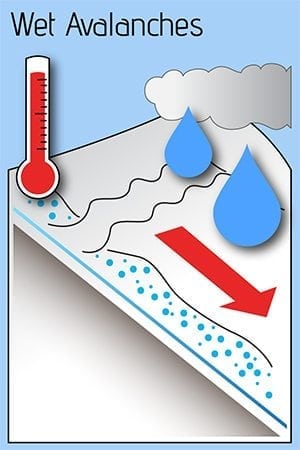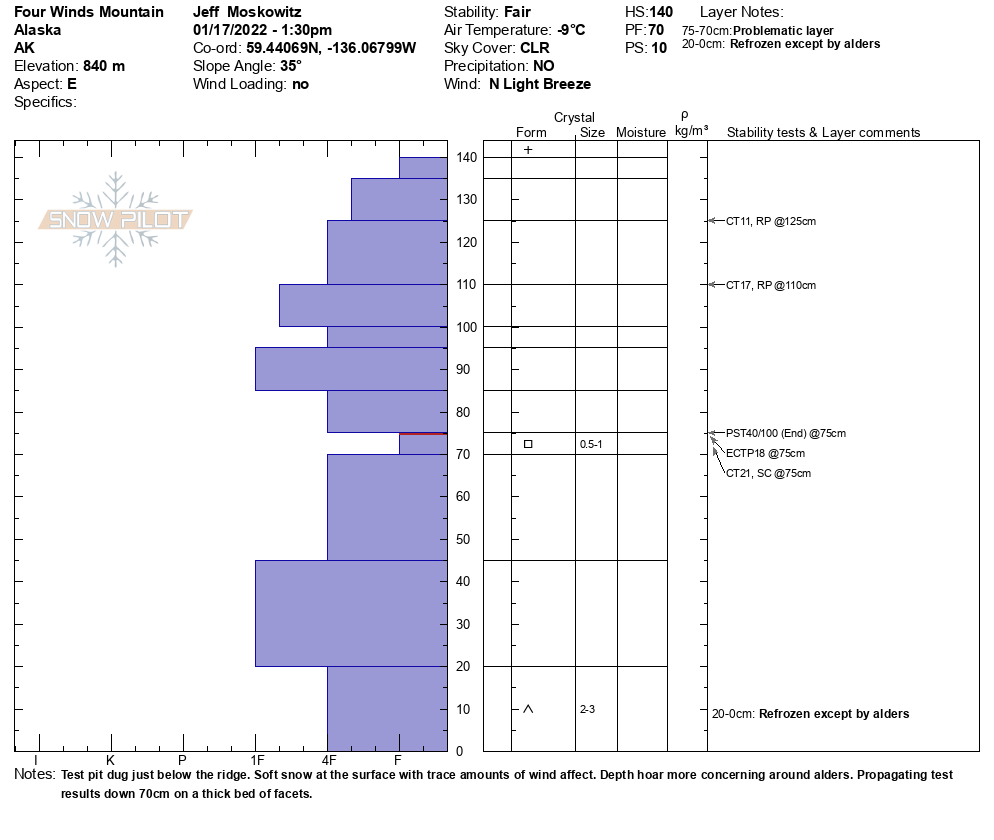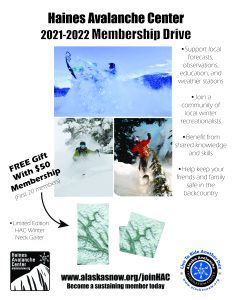Haines Avalanche Center
Above 2,500ftHigh
1,500 to 2,500ftHigh
Below 1,500ftHigh
Degrees of Avalanche Danger
Avalanche Problems
Problem 1
Aspect: All
Elevation: Below freezing levels ~2500-3000′
Bottom Line: Avalanche danger spikes to HIGH with heavy precipitation, warming temperatures, south winds and rain on snow during the atmospheric river event this weekend. Anywhere at or below the freezing level, natural wet avalanches are very likely to almost certain. This includes the potential of liquid water loosening bonds not only at the surface, but deeper down on buried weak layers, or at the ground and could produce wet slab avalanches (see persistent problem below).
Travel advice: With the nature of wet avalanches and the intensity of the incoming storm, no reliable travel technique through avalanche terrain will keep you safe. Avoiding any slopes greater than 25 degrees, connected terrain, run out zones and terrain traps are vital to not getting caught in a potentially small to large slide. Very dangerous conditions exist. Travel in avalanche terrain is not recommended.
Likelihood:
- Almost Certain
- Very Likely
- Likely
- Possible
- Unlikely
Size:
- Historic
- Very Large
- Large
- Small
Trend
- Increasing
- Steady
- Decreasing
Problem 2
Aspect: All
Elevation: All
Bottom Line: Heavy precip, rapid loading and warming temperatures will add significant stress to weak layers buried in the snowpack. Natural avalanches will be likely and human triggered avalanches are very likely. With multiple strong over weak layering throughout the snowpack surface avalanches could still step-down to trigger deeper persistent weak layers, which could cause wide propagation and very large avalanches. This storm has the potential to produce the largest avalanche cycle of the season.
Travel advice: With the nature of wet avalanches and the intensity of the incoming storm, no reliable travel technique through avalanche terrain will keep you safe. Avoiding any slopes greater than 25 degrees, connected terrain, run out zones and terrain traps are vital to not getting caught in a potentially large to very large slide. Very dangerous conditions exist. Travel in avalanche terrain is not recommended.
Lingering Persistent Weak Layers:
- Northerly aspects that escaped the wind and are harboring weak surface snow were loaded by south winds Jan. 10th
- Facets formed on the surface at the end of the arctic outflow event (around Jan, 7th) from high daily temperature swings.
- Surface hoar and near-surface facets from Dec 18th may have been preserved in wind-protected areas
- The Nov. 25th ‘Thanksgiving brittle crust‘ was found near 3,200’ and below
- Toward the very bottom: early season snowfalls and crusts linger and are very difficult to trigger but are still of concern for step-down potential.
Test pit profile and results from Jan. 17th on Four Winds Mountain with mid-Dec thick buried facets down 75cm
Likelihood:
- Almost Certain
- Very Likely
- Likely
- Possible
- Unlikely
Size:
- Historic
- Very Large
- Large
- Small
Trend
- Increasing
- Steady
- Decreasing
Avalanche Activity
01/15/2022 – An observation from Four Winds Mountain reported a collapse and a remote trigger of an approximately 200′ wide avalanche at 3,000′ on a northern aspect. It was estimated to run a couple hundred feet but low visibility kept observations to a minimum
01/17/2022 – On solar aspects past Mosquito Lake and above Lutak Inlet small point releases were reported above treeline on steep alpine features.
Weather
Forecast:
A very wet and warm atmospheric river hits Friday-Saturday. Precipitation amounts of 3-5″+ will cause flooding concerns to increase in the valleys, while the upper elevations receive multiple feet of heavy wet snow. Snow levels are likely to rise to near 3000ft Saturday. This will be a good weekend to stay home, or out of avalanche terrain.
Seasonal Summary:
- Jan 9th-15th brought 24-48″ of new snow in the alpine, with some light rain up to 3,500ft, followed by heavier rain up to 2000ft.
- Very strong NW winds and arctic temperatures blasted the area the first week of January
- Jan 1st: New snow (20″ in Lutak, 7″ Transitional zone) buried any preserved surface hoar.
- Moderate NW winds hit exposed slopes Dec 19-20th
- Surface hoar formed on all aspects and elevations Dec 17-18th
- December brought in about 2-5 feet of snowfall (highest in Lutak zone), and a few strong NW wind events
- November brought consistent heavy snowfalls, cold weather, and SE winds
- October brought heavy snow in the alpine, followed by a few rain/sun crusts
| Snow Depth [in] | Last 24-hr Snow/SWE [in] | Last 3-days Snow/SWE [in] | Today’s Freezing Level [ft] | Today’s Winds | Next 24-hr Snow/SWE | |
| Mount Ripinsky @ treeline ** | 73″* | 0″ / 0.15* | 5″ / 0.40* | 3000′ | Mod, SE | 24″ / 3* |
| Flower Mountain @ treeline | 57″ | 0″ / 0.00 | 1″ / 0.10 | 2500′ | Mod, SE | 18″ / 2* |
| Chilkat Pass @ 3,100ft | 18″ | 0″ / 0.00 | 1″ / 0.10 | 2500′ | Mod, SE | 12″ / 1.5* |
( *star means meteorological estimate )
** The Ripinsky weather station is in need of repair, and will likely be down until Summer.
Additional Information
Ride rescue ready. Be prepared for an emergency. Prevent hypothermia. Carry bear spray. Winter is a high consequence environment.
Become a sustaining Haines Avalanche Center Member by clicking the poster or visiting alaskasnow.org/joinHAC. Support local forecasts, observations, education and weather stations. Join a community of winter recreationalists. Benefit from collective knowledge and skills. Help keep your friends and family safe in the backcountry. Get a free limited edition mountain buff, or neck gaiter with a $50 membership (first 20 members!).
Practice like you play. Make sure all your rescue gear is fully functional and your beacon has NEW batteries. Make sure 1) everyone in the group has a functioning beacon, shovel and probe 2) knows how to use them and 3) has trained in companion rescue in the last year. Keep your skills fresh. If you head into the hills, watch out for red flag avalanche conditions, natural avalanches, whoomphing or collapsing, and shooting cracks.
Education Video Links:
- AIARE
- How to Practice Avalanche Rescue Snowmobile Edition: https://youtu.be/2ML499MMDfM
- AK Sled Shed Motorized Learning:
- Intro: https://youtu.be/aoagKHfGkxs
- Personal Electronics in Avalanche Terrain: https://youtu.be/2Vz9S0OEyFk
- Snowmobile Macgyver Tool Kit: https://youtu.be/4WBNu_t6Bbk
- Head and Face Protection: https://youtu.be/jIzW89wOyZI
- Pre-season prep: https://youtu.be/zJmrb8cZlR4
- My Transceiver: https://youtu.be/yblaDWP7Jf8
- BCA Avalanche Safety for Snowmobilers
- How to Fix Common Snowmobile Problems in the Field: https://youtu.be/g9fiTxEvuFk
- Sleducation: Avalanche Safety for Snowmobilers: https://youtu.be/EWFOd_9DYb8
- Intro to Avalanche Transceivers for Snowmobilers: https://youtu.be/6ZLSBmsceog
- Avalanche Transceiver Trailhead Test for Snowmobilers: https://youtu.be/rWoXbadFBsY
- Avalanche Transceiver Searching Use Snowmobiles: https://youtu.be/w1ucyI6LMXM
- BCA Avalanche Rescue Series
- Beacon Search 101: https://youtu.be/nnHXLVA2FcE
- Avalanche Probing 101: https://youtu.be/-0_yDN5Drzw
- Avalanche Shoveling 101: https://youtu.be/dGQg9o3vAkM
- Organizing a Backcountry Rescue: https://youtu.be/gywtmukgt8s
- Post Avalanche Patient Care: https://youtu.be/9FyIeUy4wpQ
- Backcountry Evacuation: https://youtu.be/WPF-dciefL8
- Complex Multiple Burials Backup Techniques: https://youtu.be/pB6AfY2KyYo
- National Avalanche Center
- Avalanche Problems Explained: https://youtu.be/DkbnT_9-cHU
- Intro to North American Avalanche Danger Scale: https://youtu.be/r_-KpOu7tbA
Alerts
Avalanche danger spikes to HIGH with heavy precipitation, warming temperatures, south winds and rain on snow during the atmospheric river event this weekend. Very dangerous conditions exist. Travel in avalanche terrain is not recommended.



